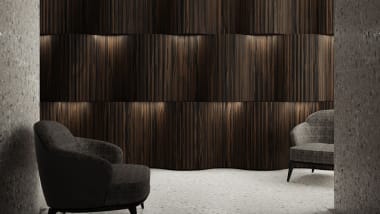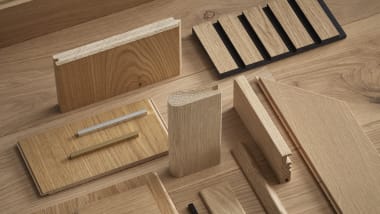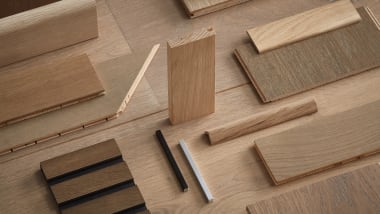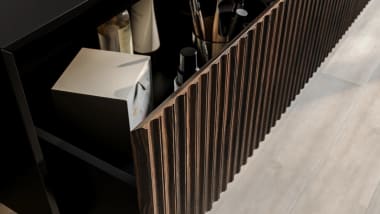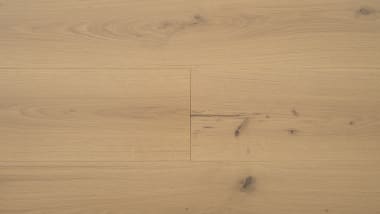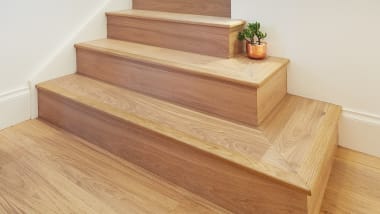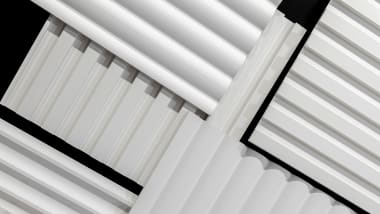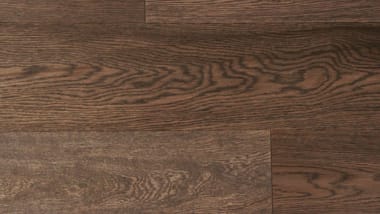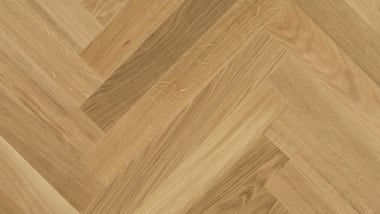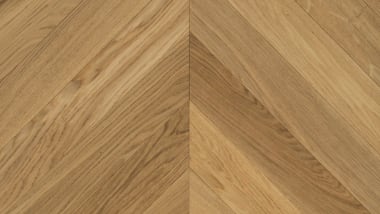Can You Put A Rug On Hardwood Flooring
25 Jul 2023
Yes, you can put a rug on hardwood flooring and there are many good reasons for doing so. There are some considerations to keep in mind, including maintenance and floor protection to ensure you get the best out of both your hardwood flooring and your rug. Read more to discover everything you need to know about putting rugs on hardwood floors.
Product in header image: HW16609C Columba Chevron timber flooring
Can you put rugs on Hardwood floors?
Yes, you can certainly put a rug on a hardwood floor. In fact, using rugs on hardwood flooring is a popular choice for many homeowners and businesses. Timber and rugs pair perfectly, providing a mix of interesting textures, tones and patterns to a space. Rugs can provide numerous benefits, such as adding warmth and comfort to a room, reducing noise levels, and protecting the hardwood floor from scratches and wear in high-traffic areas.
Benefits of placing a rug over timber flooring
Placing a rug over hardwood flooring can offer several benefits, making it a popular choice for homeowners. Here are some of the advantages:
Enhanced Aesthetics: A well-chosen rug can add warmth, texture, and style to a room, enhancing the overall aesthetics of the space. It can act as a focal point or tie together different elements of the room's decor.
Comfort and Warmth: Hardwood flooring often delivers a feeling of warmth from the beautiful natural wood tones. A rug provides an extra layer of texture and insulation, making the room cozier and more comfortable.
Noise Reduction: Hardwood floors and other hard surfaces can reflect sound, leading to more echo and noise in the room. A rug can absorb and dampen sound, reducing noise levels and creating a quieter environment.
Protection of Hardwood Flooring: Rugs act as a protective barrier, preventing scratches, scuffs, and wear on the timber floor caused by foot traffic, furniture movement, and other activities.
Safety and Non-Slip Surface: Rugs with appropriate rug pads underneath provide a stable and non-slip surface. This reduces the risk of slipping and falling, especially in high-traffic areas or homes with elderly or young family members.
Versatility and Flexibility: Rugs come in various sizes, shapes, and styles, providing flexibility in interior design. You can easily change the look and feel of a room by swapping out or rotating rugs.
Defined Spaces: Rugs can help define different areas within an open-concept room. For example, in a living room with an adjacent dining area, a rug under the dining table can visually separate the two spaces.
Easy Maintenance: Just like hardwood flooring, rugs are generally easy to clean and maintain. Regular vacuuming and occasional spot cleaning keep the rug and your timber flooring looking fresh and new.
Allergy Reduction: High-quality rugs with low-pile or natural fibres can help reduce airborne allergens, as they trap dust and particles that might otherwise become airborne. Hardwood flooring is known as a great option to reduce allergens as it does not trap allergens like dust mites, pet dander, or pollen. A properly installed and well-maintained timber flooring also helps prevent moisture from becoming trapped, reducing the risk of mold-related allergies.
Quick Room Transformation: If you want to refresh the look of a room without major renovations, changing the rug can make a significant difference in the ambiance and style.
Overall, a rug adds functionality and visual appeal to hardwood flooring, providing an added layer of colour and texture to a space. Incorporating a beautiful rug into your interior décor makes for a practical and aesthetically pleasing addition to any room in your home.
Phil Anstey Home | Havwoods HW2208 Alsace PurePlank Timber Flooring
Considerations to make when choosing a rug for your hardwood flooring
Choosing the right rug to go over hardwood flooring involves considering various factors to ensure it complements the space, provides the desired functionality, and enhances the overall aesthetics of the room. Here are some tips to help you select the perfect rug:
Size and Placement: Choose a rug size that fits well within the desired area and complements the room's proportions. Ensure the rug is centred and properly aligned with the furniture in the space.
Style and Design: Consider the overall aesthetic of the room when selecting a rug. Choose a design, pattern, and colour that harmonises with the hardwood flooring tone and existing decor and enhances the desired ambiance.
A rug can be a focal point or a subtle addition to tie the room together. If your furniture and decor are already busy, consider a more neutral rug. For rooms with a simpler design, a bold and patterned rug could add visual interest.
Size Matters: Measure the area where you want to place the rug to determine the appropriate size. Generally, it's best to leave a border of exposed timber flooring around the edges of the rug to create a visually balanced look. Common rug sizes for typical living rooms are 5'x8', 8'x10', or 9'x12', but be sure to choose dimensions that fit well with your specific room layout and furniture arrangement.
Consider Room Function: Think about how the room is used and the level of foot traffic it receives. For high-traffic areas like living rooms or hallways, opt for a durable rug material that can withstand frequent use. In low-traffic areas like bedrooms, you may choose a softer and more plush rug for added comfort.
Pile Height and Thickness: Consider the pile height of the rug (the thickness of the fibres). Low-pile rugs are easier to clean and are generally less likely to trap debris. High-pile rugs can add warmth and coziness but might require more maintenance.
Budget Considerations: Set a budget for your rug purchase. Just like hardwood flooring, rugs come in a wide price range, so having a budget in mind can help narrow down your options.
Sample Testing: If possible, order some rug samples to see how they look in your space under different lighting conditions. This will give you a better idea of how the rug will fit in with your existing decor. Alternatively, if you are still in the planning and design stage of your project, you can order free hardwood flooring samples and take them with you to select your rug design.
You are also welcome to bring any rug samples into a Havwoods showroom to see how your selected rug will look with your desired hardwood flooring product.
By considering these factors, you can find the perfect rug that not only enhances the beauty of your hardwood flooring but also complements the overall design, aesthetics and ambience of your room.
The Royce Hotel, Melbourne | Havwoods HW16609C Columba Chevron timber flooring
What types of rugs are safe to put on hardwood floors?
When selecting a rug to place on hardwood floors, it's essential to choose a rug that is safe and won't cause any damage or wear to the floor's surface. Here are some types of rugs that are considered safe for hardwood floors:
Natural Fibre Rugs: Rugs made from natural fibres like wool, cotton, jute, sisal, or seagrass are generally safe for hardwood floors. These rugs have soft backings that are less likely to scratch the floor.
Low-Pile Rugs: Rugs with a low pile height, meaning the fibers are short and tightly woven, are less likely to trap dirt and debris that could scratch the hardwood floor. Examples include flatweave rugs and Berber rugs. High-pile rugs may just take a little more maintenance to ensure dirt does not get trapped and scratch the flooring.
Flatweave Rugs: Flatweave rugs are thin, lightweight, and do not have a pile. They are a safe choice for hardwood floors, as they provide a smooth and even surface.
Natural Rubber or Latex Backed Rugs: Rugs with a natural rubber or latex backing are non-slip and will provide a secure grip on hardwood floors without causing damage.
Felted or Cushioned Rugs: Rugs with a felted surface or those that are specifically designed with added cushioning can provide extra protection for hardwood floors.
Hand-Knotted Rugs: High-quality hand-knotted rugs typically have soft backings that are gentle on hardwood floors.
Rug Pads: While not rugs themselves, using a rug pad underneath your rug and made of natural materials, such as felt or natural rubber, can help protect hardwood floors by preventing rug movement and providing additional cushioning.
Renaker Apartments, UK | Havwoods HW16006 Bronzo Herringbone timber flooring
What types of rugs can damage hardwood flooring?
Certain types of rugs can potentially damage hardwood flooring if proper precautions are not taken. Here are some types of rugs that could cause issues on wood floors:
Rugs with Rough or Abrasive Backings: Rugs with rough backings, especially those made from low-quality materials, can scratch and wear down the finish of hardwood flooring over time.
Vinyl or PVC Backed Rugs: Rugs with vinyl or PVC backings can trap moisture, leading to discolouration or damage to the hardwood floor due to lack of breathability.
Non-Breathable Rugs: Rugs that do not allow air to circulate underneath can potentially trap moisture, leading to mold or mildew growth, which can harm the hardwood flooring.
Certain Rubber Backed Rugs: Some rubber-backed rugs may contain chemicals or additives that can react with the wood floor finish, causing discolouration or damage.
Rugs with Dyes or Stains: Poorly made or cheap rugs with unstable dyes or stains may bleed through when exposed to spills or moisture, causing stains or discolouration on the hardwood flooring.
Heavy or Dense Rugs: Extremely heavy or thick rugs can cause indentations on the hardwood flooring over time, especially if left in one place for an extended period.
Rugs with Adhesive Tapes or Glues: Rugs with strong adhesive tapes or glues can leave residues on the hardwood floor and damage the finish when removed.
To avoid potential damage to hardwood flooring, it is crucial to choose rugs that have safe backings and are designed for use on hardwood floors. Additionally, using a suitable rug pad beneath the rug can provide an extra layer of protection and prevent any potential rug-related issues. When in doubt, consult with a flooring specialist or rug expert to ensure you select a rug that is safe and compatible with your specific type of hardwood flooring.
Sarner Road Home | Havwoods HW16406 Bronzo Plank timber flooring
How can a rug help protect your Hardwood flooring?
A rug can help protect your hardwood flooring in several ways:
Preventing Scratches and Scuffs: A rug acts as a barrier between the hardwood floor and foot traffic, furniture, and other objects that might cause scratches and scuffs. The rug's surface absorbs the impact, reducing the direct contact between the timber floor and potential sources of damage.
Minimising Wear and Tear: Hardwood floors in high-traffic areas can experience wear over time. Placing a rug in such areas, like entryways or hallways, can distribute the pressure and foot traffic, preventing excessive wear and tear on the hardwood floor.
Rug Pads: It is recommended to use a rug pad or underlay beneath the rug. A rug pad provides cushioning, prevents the rug from sliding, and helps protect the timber floor from potential damage caused by friction between the rug and the floor. Additionally, it acts as a shock absorber, effectively cushioning the impact of foot traffic and safeguarding the rug's fibers from crushing, ultimately contributing to the rug's extended lifespan. Moreover, the rug pad acts as a protective barrier, effectively warding off the accumulation of grime and dirt underneath the rug, ensuring a cleaner and more hygienic environment.
Protecting from Spills and Stains: Accidental spills can occur in everyday life. A rug can act as a protective layer, absorbing spills and preventing liquids from seeping into the hardwood floor and causing stains or water damage.
Reducing Fading: Direct sunlight can cause fading and discolouration of hardwood floors. Placing a rug in areas exposed to sunlight helps shield the floor from harmful UV rays, preserving its original colour and appearance.
Preventing Furniture Marks: Furniture legs can leave indentations on hardwood floors. By using rugs under furniture, you create a buffer that reduces the chances of these marks and dents.
The Crescent, Mosman Village | Havwoods HW2130 Allevard PurePlank timber flooring
How to clean and maintain your rug
Remember, while rugs offer protection and can enhance the appearance and functionality of a hardwood floor, it's important to regularly clean and maintain both the rug and the flooring to ensure their longevity and prevent any potential damage.
Floor Protection: It's essential to periodically lift and clean the rug to prevent any debris from accumulating beneath it. This will help maintain the condition of the hardwood floor by preventing the rug from trapping dirt, which could potentially scratch the floor’s surface.
Regular Sweeping and Vacuuming: Sweep or vacuum hardwood floors and rugs regularly to remove dirt, dust, and debris. Rugs can also be regularly shaken to remove loose dirt, dust, and debris. For rugs, Use a vacuum cleaner with a brush attachment, especially for delicate or high-pile rugs. Avoid using vacuums with beater bars on hardwood flooring, as they can scratch the floor's surface.
Rotate the Rug: Regularly rotate the rug to ensure even wear and tear. This is especially important for rugs placed in high-traffic areas.
Wipe Spills Immediately: Clean up spills promptly to prevent water damage and stains on the hardwood flooring or on the rug. Use a soft, absorbent cloth to blot the spills. avoid rubbing, as it can spread the stain. Learn how to care and maintain for hardwood flooring here.
Professional Cleaning: Periodically, have your rug professionally cleaned to remove deep-seated dirt and stains and rejuvenate its appearance.
By following these tips, you can extend the lifespan of both your rug and timber flooring and keep them in excellent condition for years to come.
Chelsea Townhouse, UK | Havwoods HW2044 Alsace Herringbone timber flooring
Rugs are a Perfect Addition to a hardwood floor for your Interior Design
Yes, rugs provide the perfect addition to a room, delivering enhanced aesthetics, comfort and warmth, noise reduction, floor protection and a stunning focal point and an added layer of soft texture to your space. Easy to maintain, just like hardwood flooring, a rug could be just what you need to add that special touch to finish off your space.
See an example of a perfect pairing of hardwood flooring and hand-made, artisan rugs at the Armadillo & Co Showroom.
Order Free Samples Online
In the planning and design stage? We have over 200 hardwood flooring products for you to choose from. Find the perfect match for your perfect rug.
Simply explore our products, see a product you like? Click the "add to cart" button. When you are ready, check out and fill in your delivery details and we will pack and send off your samples direct to you at your home or office.
Explore our range of European Oak hardwood flooring products online today and find the perfect product for your project.



